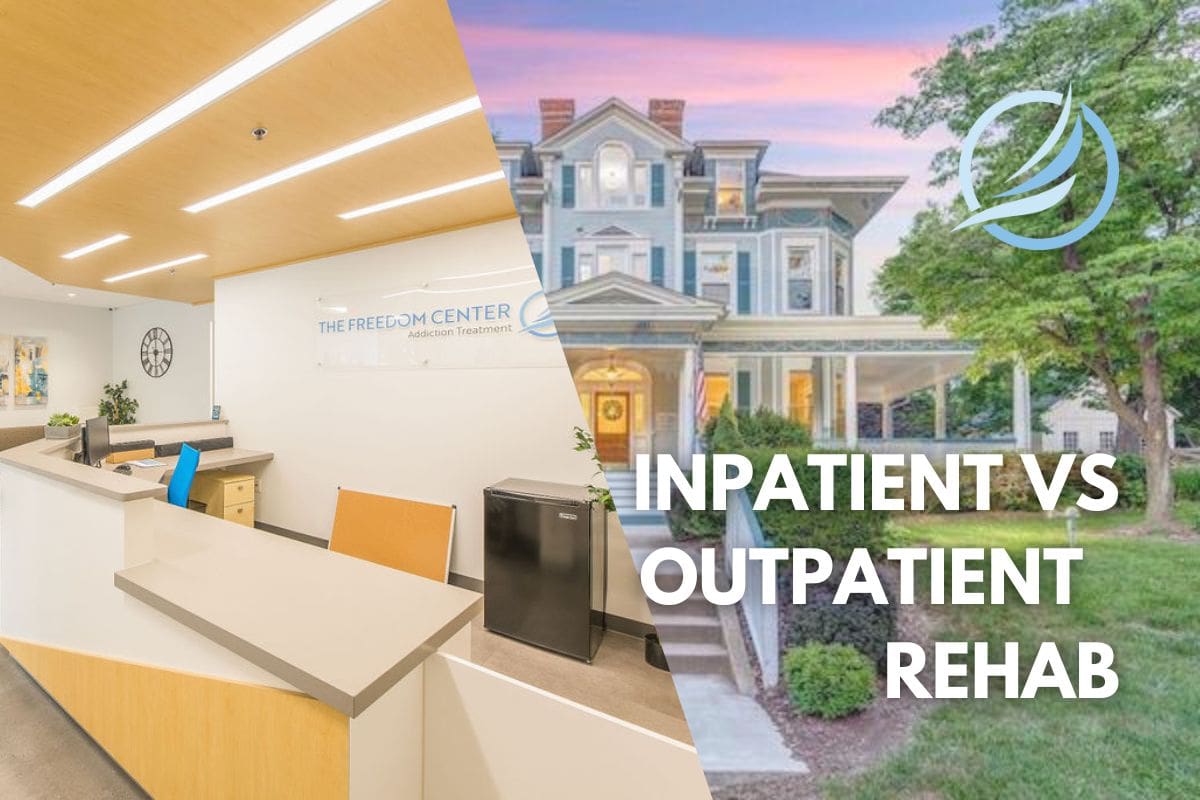Substance abuse and addiction affect millions in the US and worldwide, but relatively few receive the help they need. So, if you are looking into drug or alcohol rehabilitation programs, you may be wondering about the differences between inpatient and outpatient rehab, two of the most popular treatment modalities.
This article will help you understand the differences between these treatment types to determine which fits your needs best, helping you make more informed decisions regarding your or your loved one’s addiction treatment.
What Is Drug and Alcohol Rehab?
Drug and alcohol rehabilitation, or “rehab,” is the process of helping people who struggle with substance abuse overcome their addiction and achieve long-term recovery.
Since addiction is complex and involves many factors that manifest uniquely in each person, drug and alcohol rehab is multifaceted, involving medical, psychological, and social interventions tailored to each patient’s needs.
Rehab programs focus on breaking the physical dependence on substances through detoxification while also addressing the mental health, familial, and social aspects of addiction. To provide a whole-patient solution to addiction, rehab programs use various therapies, counseling sessions, and support groups to uncover and treat the underlying causes of addiction.
Once the patient has gone through detoxification, these counseling sessions and support groups teach them the coping strategies and life skills necessary to maintain sobriety throughout the rest of their lives.
The ultimate goal of drug and alcohol rehab is to help people with addiction achieve lasting sobriety and rebuild their lives, returning to a healthy, productive lifestyle free from substance dependence.
Inpatient Drug and Alcohol Rehab
Inpatient drug and alcohol rehab is one of the most common types of rehab programs and the one that offers the most intensive and structured care. In inpatient rehab, patients stay in a rehab facility throughout their program, lasting from a few weeks to several months.
Who Is Inpatient Rehab for?
Inpatient rehab is particularly beneficial for people with severe addiction, a history of relapses, or co-occurring mental health disorders. Inpatient rehab is also a good choice for those who lack a robust support system or whose familial or social environment promotes drug use.
It offers a safe, controlled environment away from daily stressors and potential triggers, providing the right circumstances to foster the deep focus on recovery that will lay a strong foundation for long-term sobriety.
Benefits
The main benefits of inpatient treatment are:
- A structured and supportive environment is crucial for early recovery.
- 24/7 medical supervision and access to professional care.
- Access to intensive therapy like individual, group, and sometimes family counseling.
- In-person peer support from people who are going through similar challenges.
Finally, the removal from everyday life and all its triggers helps patients to focus entirely on their recovery without the distractions or temptations of their regular environment.
Potential Drawbacks of Inpatient Treatment
Despite its many benefits, inpatient treatment is not the best fit for everyone going through addiction recovery. Some of the potential drawbacks of inpatient treatment include:
- High cost. Inpatient treatment is usually more expensive than other types of treatment, limiting access for people who need it.
- Highly immersive environment. For some people, immersing themselves in a new environment where they’ll be isolated from their support system for at least a few days is not conducive to recovery.
- Rigid structure. A daily structure can be very effective in addiction recovery. Still, some people need more flexibility and may resent the structured environment and relative lack of personal freedom.
- The post-treatment transition can be challenging. The sterile environment of inpatient rehab centers is excellent for addiction recovery but is often not representative of the real-life triggers people face in recovery. As a result, it’s necessary to have a solid aftercare program to maintain sobriety after inpatient treatment.
Outpatient Drug and Alcohol Rehab
Outpatient drug and alcohol rehab is a flexible approach to addiction treatment, allowing individuals to live at home and maintain their daily responsibilities while receiving care.
In outpatient rehab, patients typically receive scheduled therapy sessions multiple times a week at a treatment center. These sessions occur outside work and accommodate the patient’s schedule, helping them better balance work, treatment, and life.
Who Is Outpatient Rehab for?
Outpatient rehab is best suited for people who have already gone through inpatient treatment and are now undergoing a less intensive, gradual, long-term form of addiction treatment.
It’s also possible to receive outpatient addiction treatment without having gone through inpatient treatment first. Examples include people who are facing mild addiction and cannot afford to leave their jobs for several weeks.
In these cases, patients should ideally fulfill the following requirements:
- Mild to moderate addiction.
- A robust support system at home.
- A high level of motivation to recover and an ability to self-regulate effectively.
Ultimately, outpatient is better for those who want to receive addiction care in a more flexible environment.
Benefits
The main benefits of outpatient treatment are:
- Flexibility. Patients can schedule therapy and counseling sessions around their personal and professional commitments, enabling them to continue their daily lives during treatment.
- Lower cost. Outpatient treatment is more affordable than inpatient care.
- Real-life experience. Patients can immediately start applying their newly found coping skills in their everyday lives.
Potential Drawbacks of Outpatient
Like inpatient rehab, outpatient is great in certain circumstances but is not for everyone. Some of the potential limits and drawbacks of outpatient treatment include:
- Less structured environment. Some people thrive in more structured, rigid routines, which outpatient treatment doesn’t provide.
- More exposure to triggers. Since patients continue to live in their usual environment, they may be more exposed to triggers and less isolated from the stressors that contribute to substance abuse.
- Less intense care. Support is less intensive compared to inpatient treatment, which might be insufficient for those with severe addiction or co-occurring mental health disorders.
- More dependent on self-reliance. The success of outpatient treatment heavily relies on the patient’s commitment and self-discipline, which can be challenging for some.
Inpatient vs. Outpatient Rehab: A Quick Comparison
This table summarizes the differences between inpatient and outpatient rehab for drug and alcohol abuse.
| Inpatient | Outpatient | |
| Setting | A clinic, hospital, or rehab facility | Patients live at home and attend regular therapy sessions |
| Duration | A couple of weeks to 90+ days | Often several months, but varies widely among patients |
| Intensity of Care | High-intensity with 24/7 monitoring | Lower intensity with scheduled treatment sessions |
| Rigidity of Structure | Rigid structure with strict rules and little personal time | More personal free time and fewer rules |
| Cost | Higher cost | Lower cost |
| Life-Treatment Balance | Poor balance. Patients stay in the facility for the duration of the treatment | More balance. Patients have more time to attend to responsibilities and recreate while accessing ongoing care |
| Treatment | Detox, medication management, and various forms of psychotherapy | Medication management and multiple forms of psychotherapy |
| Suitability | Suited for severe addiction or dual diagnosis (addiction and mental illness) | Suited for self-disciplined individuals with mild to moderate addiction and strong home support |
| Peer Support | Immersive community with other inpatients | Limited interaction with peers unless you join a support group or your program involves group therapy |
Inpatient vs. Outpatient Drug and Alcohol Rehab Success Rates
Given the differences in treatment formats and methodologies to quantify success, it’s hard to determine which is more effective for helping you overcome drug or alcohol abuse.
According to the National Institute on Drug Abuse, substance use disorders (SUDs) have a slightly lower average relapse rate than other chronic illnesses like asthma and hypertension, with 40% to 60% of people who receive treatment for SUDs relapsing at some point.
However, relapse doesn’t mean that treatment failed. Treatment of chronic diseases involves modifying deeply rooted behaviors, which happens gradually. If someone relapses after or during treatment, it means they should contact their provider to resume or modify treatment to suit their specific needs.
Factors to Consider When Choosing Between Inpatient and Outpatient Treatment
When choosing between inpatient and outpatient treatment, you should consider the severity of the addiction, your commitments, and the strength of your support system.
Inpatient treatment suits severe addiction better by offering intensive care, which is ideal for those who benefit from a structured environment and constant support. Outpatient treatment is more flexible, allowing you to maintain daily responsibilities while receiving care. As a result, outpatient is best for mild to moderate addiction cases with a vital home support network.
Choosing one or the other depends on your specific needs and financial availability, as inpatient programs are usually more expensive due to their residential nature and intensity of care.
Regardless of which you choose, it’s essential to recognize the need for addiction treatment. If you or anyone close to you experiences substance addiction, you should seek professional support as soon as possible.

































